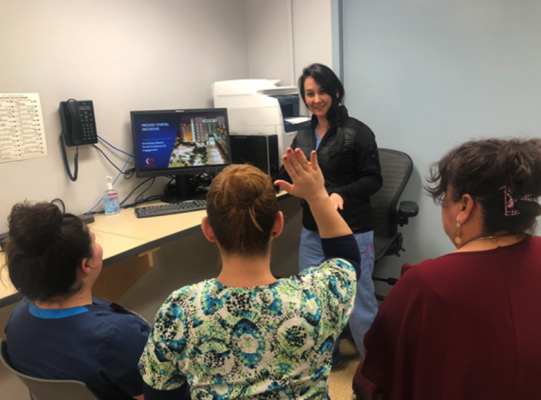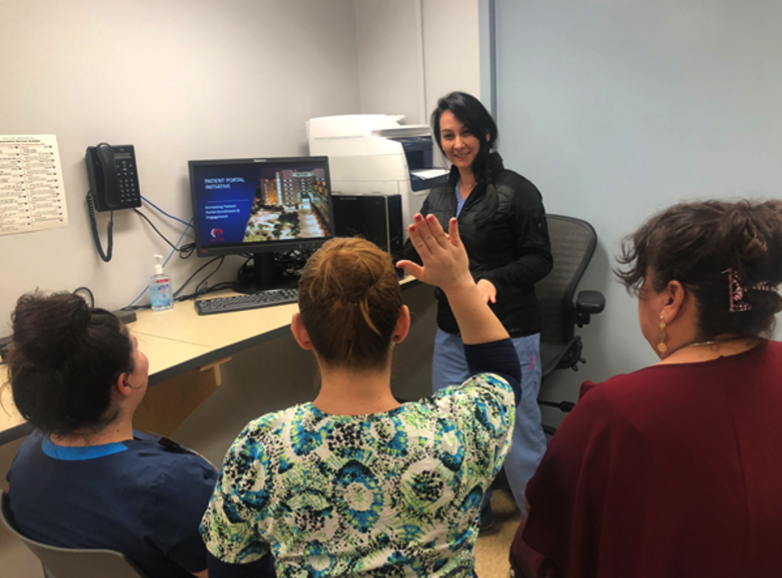
In pre-COVID days, there was nothing like the promise of a pie party/pizza party/tamale party—pick your favorite food adventure—to get the competitive juices flowing and tempt taste buds in the workplace, all for a worthwhile cause no less.
That’s the route the Los Angeles Department of Health Services (LADHS) took to bump up patient enrollment in its MyWellness patient portal, which was launched back in March 2015 with initially modest results. For example, at one LADHS primary care clinic just 4 percent of enrolled patients had signed up for the service by January 2018.
The portal is designed to give patients real time, remote access to their health information via mobile app or online website 24/7. Patients can request appointments and refills, check lab and radiology results, review provider notes (see CCI’s story on LADHS’s OpenNotes program) and communicate with health team staff with the goal of improving their health and wellness. Even patients without cell phones or computers can access their online portal for free through the public library.
In the past five years the county-wide program has picked up considerable momentum, in part through concerted efforts by tech innovators. In 2019, as part of CCI’s Catalyst program, LADHS took measures to boost enrollment at a clinic with low engagement. (See story here.) And when the department brought in OpenNotes in January 2018, active patients on the MyWellness patient portal increased by 100 percent over the year, from 12,500 a month in January 2018 to 24,000 a month in December that same year.
That said, more than 600,000 patients are served each year by this safety net health system, which reaches across the entire county—some 4,753 miles—from Antelope Valley in the north to Long Beach in the south. The second largest county health system in the nation, LADHS, a leader in trauma and burn care, includes four hospitals and 25 multispecialty and primary care clinics. It serves urban, suburban, and rural residents in this sprawling metropolis, including low-income residents, unhoused individuals and families, disabled patients, non-English speakers, and people with addiction issues. Around 80 percent of its patients receive Medi-Cal and about 50 percent are best served in Spanish.

Dr. Anshu Abhat
Given the room for improvement, staff tasked to address such matters were keen to increase patient portal enrollment, particularly across primary care settings. Led by Anshu Abhat, an internist at Harbor-UCLA Medical Center in LA’s South Bay who is also the director of care transitions and patient engagement in Population Health at LADHS, innovation leaders figured they might be able to nudge those numbers higher by energizing new care teams and team members to reach out to enroll patients with a fun incentive and a little healthy competition.
Their goal: An increase of 10 percent above each clinic’s current baseline of enrollees or at least 25 percent of empaneled patients enrolled on the platform by the beginning of January 2019.
And so the savvy LADHS tech folks, along with the system’s crack marketing team and clinic staffers who are already MyWellness evangelists, began brainstorming ways to get potential participants excited about the initiative. Beyond the benefits to patients and care teams to signing up patients for MyWellness, what might motivate employees to go the extra mile and entice their clientele to enter the digital front door?
They settled on a food competition because, as Abhat need not ask but did anyway: “Who doesn’t love a free lunch?”
Party on
Setting aside personal preferences on the food front—are you a pepperoni die-hard or a pineapple-on-pizza-is-not-weird person?— the advantages of moving patients online are many.
Patients want to be able to access their health information, appointment information, and reach their clinic teams in a timely fashion. They’re not interested in long hold times for customer care calls or having to physically come into a clinic to sign a form or pick up an X-ray. And, of course, that sentiment has only been reinforced during pandemic times, even among safety net patients who face additional challenges and concerns about inputting personal information online.
Without an online portal, frustrating scenarios—like the one LADHS shares in its 2018 guide, All Hands on Deck for MyWellness Portal Toolkit — were not uncommon. “A primary care patient went to a lab for results. The lab told him that he should go to our clinic for his results; he came to our clinic angry and frustrated,” explains Ivania Cervantes, a clerk formerly at the Primary Care Adult West LAC+USC Medical Center in East L.A.’s Boyle Heights neighborhood. “He was told that while we cannot provide him his results, we could assist him in enrolling in MyWellness portal. He enrolled, viewed his labs, and came back to clinic three weeks later. He expressed how grateful he was for being able to see his labs without having to go to medical records and pay for them.”
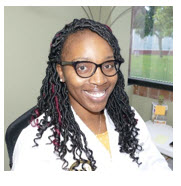
Tasha Dixon, MD
Physicians are fans of the platform too. “I’m able to provide more information to my patients and they’re able to review their notes and labs, so it’s kind of like having a second doctor around when you’re home and you’re wondering what that lab value was or if you want to send me a message,” explains primary care physician Tasha Dixon of LADHS, who works at the Martin Luther King, Jr. (MLK) Outpatient Center in Willowbrook, located north of Compton and south of Watts.
Similarly, health care teams appreciate that online portals reduce the number of interruptions staff experience from patients calling or coming in without an appointment while they’re addressing another client’s needs or other tasks. Clearly, it’s a win-win-win to have patients accessing information online. (See our story on one rural safety net clinic’s efforts to implement online patient portals as part of a case study series on CCI’s Technology Hub program, which, with support from the California Health Care Foundation, partners with safety net clinics such as LADHS to vet, pilot, evaluate, and integrate innovative digital health solutions designed to benefit underserved communities.)
As LADHS notes in its MyWellness guide: “The portal makes it easier for our patients to be fully engaged in their own care – 24 hours a day. The portal saves everyone time and hassle…A more efficient clinic means happier patients and providers.”
No arguments there.
And you know what else makes clinic staff happy? The opportunity to win a free meal during work hours. Appealing to staffers’ taste buds, clinics with the highest enrollments in November received a pie party (themed for Thanksgiving), a tamale party in December, and a pizza party in January as part of the three-month long online enrollment push.
There were other perks to whet people’s appetites. Individuals who signed up the most patients would be singled out in a LADHS monthly email and in a DHS-wide newsletter article—accompanied by flattering photos of the sign-up champs and a chart tallying up their total scores.
And, of course, winners would have bragging rights over their competitors—make that co-workers.
Let the enrollments begin!
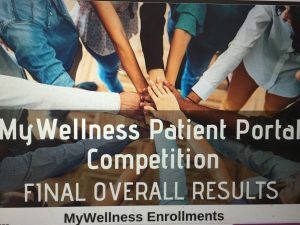
We Have a Winner
Everyone loves a winner. But the department understood how crucial it was to set all the competition participants up for success. Each staffer had access to its detailed, step-by-step guide on how to enroll a new patient, which included workflow procedures and a sample script.
The script walked team members through how to address yes or no responses to questions. Here’s an example: “May I have your email address?” If the answer is “no” the follow up could be: “Do you have a family member or friend who helps you manage your healthcare information? I can set them up as a ‘proxy’ for your MyWellness account. A proxy is an authorized user that has permission to access your account. They will have full access to help you manage your health information and your medical records.”
Having an email address is not a given, explains Abhat, especially for safety net clinic attendees. Patients may have smart phones but lack access to an email service. Some may not feel comfortable sharing information online or have privacy concerns. Successfully navigating such obstacles and assuaging such fears are part of the process.
To add a little frisson to the exercise, employees could track individual clinic statistics on the MyWellness Dashboard on the LADHS website, which tabulated both invitations to enroll and actual enrollments each month.
The three-month competition proved popular, with unexpected winners in the mix. For instance, staffers at the Curtis R. Tucker Health Center in Inglewood figured out early on that fast, private online results to STD tests was a big draw to getting patients on board with the MyWellness portal.
Most importantly, the health care system saw a significant climb in patient portal enrolments during the competition. In November 2018 1,480 new patients signed on to the portal. In December another 1,680 joined the online ranks. In January 2019 that figure jumped up by another 2,482 sign ups. The data was a little short of the department’s original goal for the initiative. No matter: The program has been building on this momentum ever since, and enrollment is increasingly robust.
A big uptick in enrollment
By September 2019, in fact, around 55,000 patients had signed up for the service across all sites. That figure has surged to more than 90,000 as of August 2020—that’s around 21 percent of patient members—with enrollment of around 2,500 a month during 2020. Some of that uptick can be traced to a concerted effort in April and May of 2020 when call center staff reached out to 55,000 patients who had not yet enrolled in the program; the COVID-19 pandemic has only made these kind of virtual tools even more relevant.
The department tallied the top ten staffers for MyWellness signups across seven different competition categories. Perhaps most impressively—as an indication of system-wide buy-in to the effort—almost every LADHS clinic or center was represented in the winners’ circle across all categories. Prizes were awarded to the clinic and individual staffer each month that had the highest sign ups.
Congratulations went to top dog Jose Cordova of the North Hollywood Health Center—also well known for its STD testing service—who personally signed up just shy of 150 patients in the competition period. In the overall category, runner up ribbons go to Irma Soto of the MLK Outpatient Clinic for around 100 sign ups and 3rd place setter Maria Coronado, also from MLK, for her hefty contribution to the cause. But dozens of staffers brought 5,642 patients online.
 The food was undeniably a big hit—we’re talking tamales, people—as was the fanfare and fuss for the individual and collective efforts. But let’s not lose sight of the real winners here. Happy patients = happy clinic staff. And judging by the feedback, patients are grateful for this online service. “I have this patient who would forget her appointments and come in on the wrong week,” explains Coronado, a greeter and MyWellness champion at MLK Outpatient Center. “So I helped her sign up for the MyWellness patient portal. Now when I see her she tells me: ‘I’m happy, Maria, because I’m here today and today’s my appointment! I don’t miss appointments anymore, it’s all here,’ pointing to her phone. I feel happy for them because I did something good for my patients.”
The food was undeniably a big hit—we’re talking tamales, people—as was the fanfare and fuss for the individual and collective efforts. But let’s not lose sight of the real winners here. Happy patients = happy clinic staff. And judging by the feedback, patients are grateful for this online service. “I have this patient who would forget her appointments and come in on the wrong week,” explains Coronado, a greeter and MyWellness champion at MLK Outpatient Center. “So I helped her sign up for the MyWellness patient portal. Now when I see her she tells me: ‘I’m happy, Maria, because I’m here today and today’s my appointment! I don’t miss appointments anymore, it’s all here,’ pointing to her phone. I feel happy for them because I did something good for my patients.”
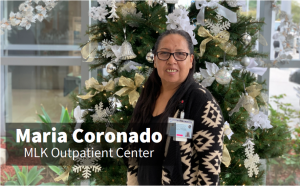
MyWellness Champion Maria Coronado
MyWellness portal champions are clinic staff members who helped lead the charge on this competition. Teams vary from clinic to clinic but typically they include two clerks (frontline staff), a lead nurse, and the nurse manager and medical director at a clinic. The staff members are chosen because they’re familiar with various aspects of clinic operations – from checking in patients to treatment to clinic management – and are committed to the goal of boosting portal enrollment. Unsurprisingly—since these early adopters are already true believers—they did well in the competition and helped to show other staffers the importance of introducing the enrollment practice to patients as a routine part of clinic culture, says Abhat.
In some cases, sign-ups are a family affair. “We get kids taking care of their parents. So we tell them to use the MyWellness patient portal so they’ve got access to everything they need,” says Theresa Bush, a clerk who also works at the MLK Outpatient Clinic. “There’s shared caregiving so all of them can go into the portal and they’re on the same playing field, all of the information is right there for them.”
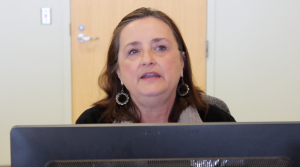
Clerk Theresa Bush of MLK Outpatient Clinic
And for many patients, the service is a vital link. “One of my primary care patients has multiple chronic conditions, does not have a phone, and lives in his car,” explains primary care physician Manuel Campa, who practices at Primary Care Adult West LAC+USC. “The only way he has been able to access his care team when he is outside of clinic is via the MyWellness message feature. He goes to his local library to communicate about both his physical and mental health concerns,” adds Campa. “He says that the MyWellness portal helps him “feel connected to our clinic. He also says he is “more easily able to express himself via message feature than in person.”
Clearly, the advantages of these online platforms go beyond the obvious benefits to patients and staff alike.
Lessons Learned
Set staff up for success.
Solicit the help of in-house number crunchers. Gathering the data for the competition proved more challenging than originally anticipated: It took several rounds of data analytics to determine the winners, which slowed down the department’s ability to share results. LADHS is also working with its Electronic Health Records provider, Cerner, for assistance with data gathering. (Cerner is the vendor for MyWellness).
Shore up admin support in advance.
Organizing the actual parties, ordering food, and interviewing staff about the competition on party days took significant time and labor. Factor in administrative support staff for this part of the project before the competition begins.
Allow for growth.
Spreading the competition over three months allowed for the initiative to pick up steam among staff. There was steady, significant growth in sign-ups from one month to the next.
Track results in real time.
Look at the data regularly to see which staff and clinics have engaged with the effort and offer encouragement—and a gentle nudge where needed—to boost the effort overall.
Next Steps
A pie party and your head shot in the in-house newsletter for the whole department to see is all very lovely. But how to keep that goodwill momentum going once the rush from winning has worn off? It’s important to work with clinic quality improvement teams—at both high and low performing clinics—to better understand results, says Abhat. Ask staffers what’s working (and, equally importantly) what isn’t, in their efforts to enroll clinic patients to MyWellness.
And keep going: continue to measure engagement and enrollment efforts, work towards monthly and annual goals for increasing engagement and keep employees in the loop, she adds.
Encourage feedback from clinical staff about ways to optimize and improve the patient portal tool and follow up on their suggestions. For example, dermatology clinics would like an easy way for patients to upload photos, since that’s important for skin care concerns, notes Abhat.
https://twitter.com/AnshuAbhat/status/1020821786655535104?s=20
Similarly, continue to seek patient feedback on the portal tool through surveys, family advisory councils, and other ways to make the platform as patient friendly and useful as possible. For instance, in patient portal guides it makes most sense to lead with scans of the mobile app platforms, Abhat explains, since 75 percent of patients access the platform from their smart phones.
The department also wants to tailor the platform for specific specialties and conditions — for instance, offering tweaks for those who work at, say, a diabetes clinic. And it wants to include an enhanced data dashboard, increase Spanish language optimization, and roll out its own branded app for easy access for new patients looking for MyWellness on the app store, according to Abhat.
Towards those new goals, the department is planning a platform revamp during the next six months to launch new and improved options for patients. Abhat says the updated platform will include additions such as self-scheduling for say, flu shots; integrated video visits; and remote monitoring of conditions such as blood pressure.
“Once we get patients in the digital front door they see that there are so many tools they can use to keep track of their health,” she says. “It’s really the foundation for our health system and where we do a lot of our work around patient engagement. We want this portal to be an integral part of the fabric of how we deliver care to all our patients.”
It’s not without obstacles. “Our safety net patients need a lot of guidance to help them comfortably and confidently navigate online tools,” says the internist, “but once they do they accept online access as part of the new clinical normal in healthcare.”
Once the revamp is completed, Abhat says the department will likely host another initiative to boost enrollment. And, yes, food party prizes could well be in the mix. Standby for Taco Tuesdays.
Find this useful or interesting? We’re constantly sharing stuff like this. Sign up to receive our newsletter to stay in the loop.

